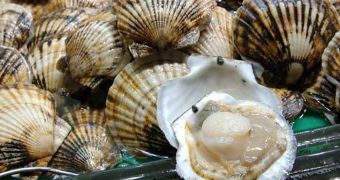Global warming and climate change are the poster kids for what happens when loads of greenhouse gas emissions set up camp in our planet's atmosphere.
However, ocean acidification is not to be ignored either, and a recent scallop mass die-off documented in Canada stands as proof that this phenomenon is just as harmful to natural ecosystems and human society than its more popular siblings are.
Not to beat about the bush, Think Progress tells us that, according to media reports from said country, ocean acidification has killed about 10 million scallops near Qualicum Beach on Vancouver Island.
Consequently, Island Scallops, i.e. a local producer, found itself registering losses amounting to an impressive $10 million (€7.28 million), the same source details.
Information shared with the public says that the $10 million worth of scallops that acidic waters killed were the equivalent of harvests usually obtained over a period of three years.
More precisely, it would appear that the company has lost almost all the scallops that it put in the ocean in 2010, 2011, and 2012 and planned to harvest after allowing them to develop for three years.
Talking to the press, Rob Sounders, the current CEO of Island Scallops, explained that, in the aftermath of this incident, he was left with no choice except sack about one third of the company's staff.
“I'm not sure we are going to stay alive and I'm not sure the oyster industry is going to stay alive. It's pretty dramatic,” he told the press.
“We've had to cut back considerably. There's nothing we can do to the ocean to change things,” Rob Sounders further explained.
According to Parksville Qualicum News, the acidity of the waters in which said company rears its scallops used to be one of 8.1 or 8.2. However, measurements indicate that local PH levels now revolve around 7.3.
Because of this increase in the water's acidity, scallops are becoming increasingly fragile and vulnerable to infections. Hence their dying in large numbers.
As Ros Sounders put it, “The high acidity level means the scallops can't make their shells and they are less robust and they are susceptible to infection.”
Specialists explain that ocean acidification is the result of the fact that high amounts of carbon dioxide released into our planet's atmosphere by various human activities are being absorbed by water sources across the world.
In fact, studies have shown that about 25% of the carbon pollution that human society produces on a yearly basis eventually works its way into seas and oceans.
The more carbon dioxide they absorb, the more acidic seas and oceans become. Consequently, several organisms find that they have trouble building their shells.

 14 DAY TRIAL //
14 DAY TRIAL //